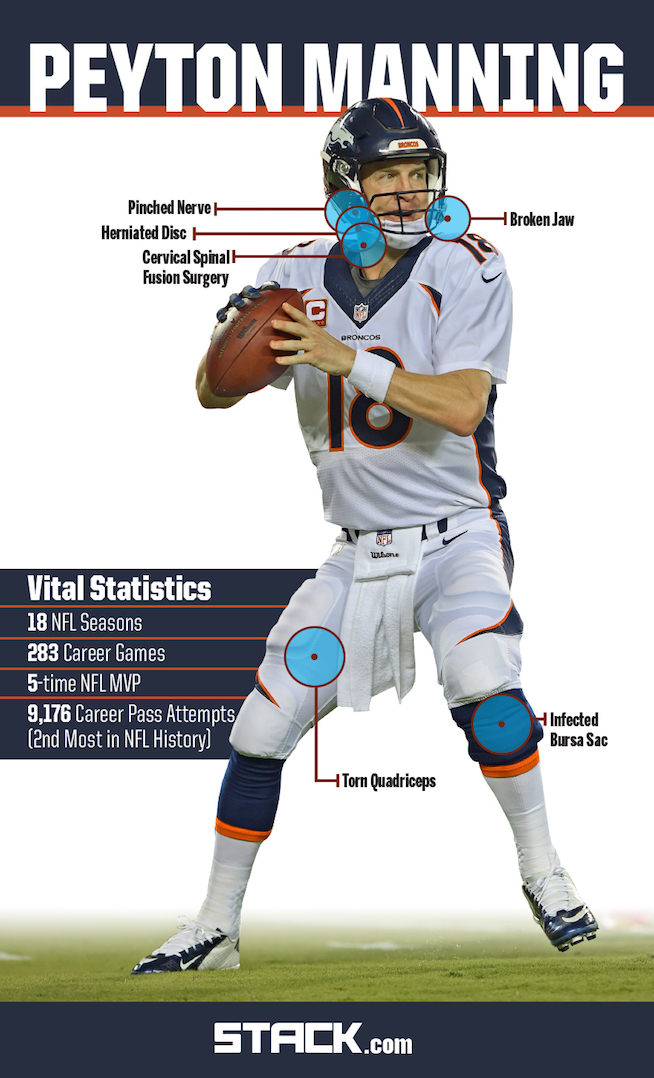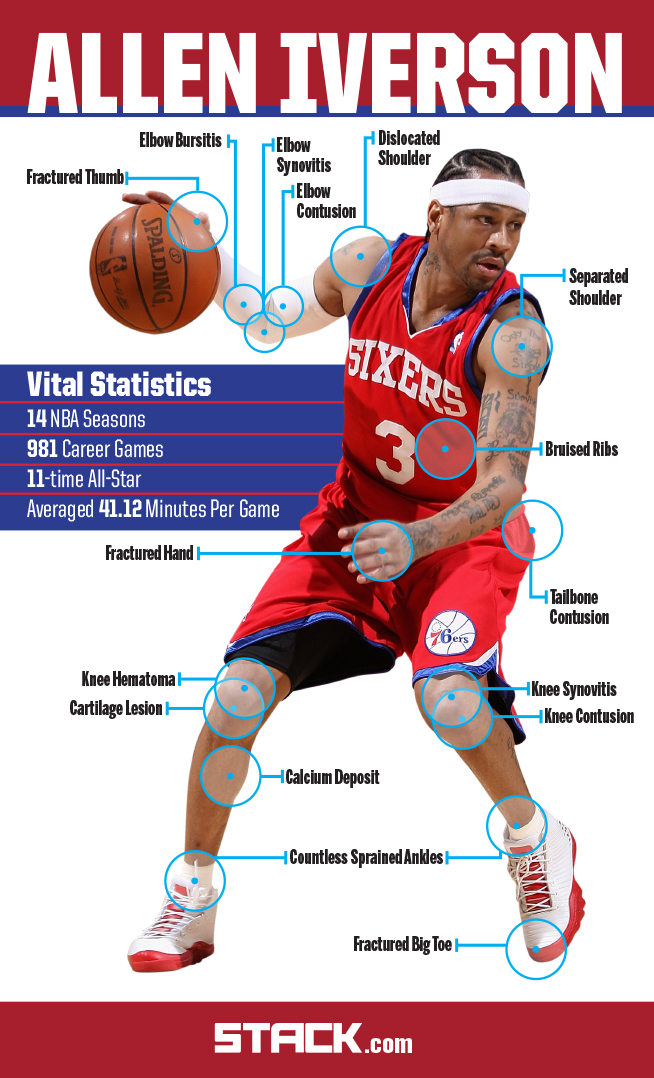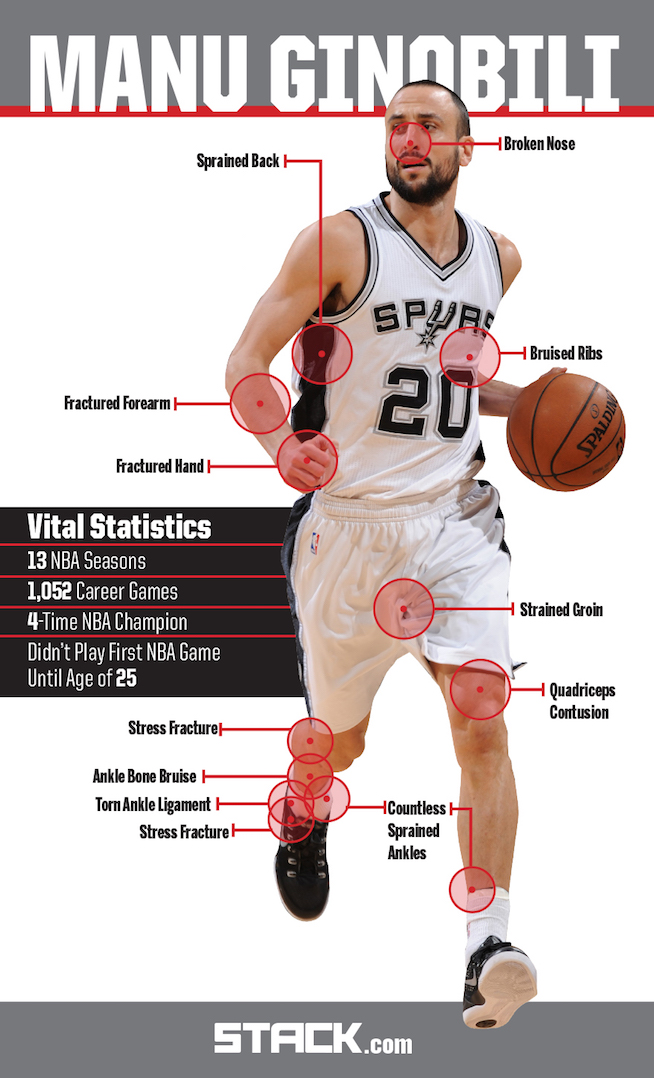Peyton Manning and 4 Other Superstars Who Overcame a Stunning Number of Injuries
The life of a professional athlete can seem impossibly glamorous. Bright lights, endorsements deals, adoring fans, multi-million-dollar contracts—what’s not to like? If most people were offered a chance to trade places, they’d do it in a heartbeat. But it’s easy to forget the sacrifices these players make. Most notably? Their bodies.
Professional athletes destroy their bodies play after play, game after game, season after season. Injuries pile up, but their passion and drive trump their desire for self-preservation. They might walk into the locker room after a game with their joints cracking, their muscles burning and their heads spinning; but by the time the next contest rolls around, they’re suited up and ready to go.
The following five superstars found a way not only to play through extraordinary amounts of pain, but to be elite in spite of it. To help you visualize their wear and tear, we’ve put together graphics that highlight their most painful injuries.
Peyton Manning
Peyton Manning stayed pretty healthy for the first decade of his professional career, suffering only two serious injuries. He had his jaw broken by a hard hit in 2001, and he played the very next week (fueled by a liquid diet). In 2008, he had an infected bursa sac in his knee that required surgery in the off-season, but he didn’t miss any time. Between 1998 and 2010, Manning started every game for the Indianapolis Colts.
RELATED: How to Train like Peyton Manning
Things quickly changed when what had once been a nagging neck problem progressed to a severely debilitating injury. It’s believed that Manning initially injured his neck in 2006, when he took a nasty hit during a game against the Redskins.
Manning never personally identified the root cause of his neck issues, and he probably played through a lot of pain during his final four years with the Colts. But the pain eventually became unbearable, and Manning missed the entire 2011 season after undergoing four surgeries in less than two years, all to the right side of his neck.
The most serious procedure was cervical spinal fusion surgery. At the time, it looked like Manning might never play again. He was 35 years old and had endured career-threatening surgery. You know the rest—he joined the Broncos and has been amazingly good. But the pain he struggles with each and every game is ridiculous. Due to lasting nerve damage, he still lacks feeling in the fingertips of his right hand, and simply getting undressed after a game is an agonizing ordeal that requires assistance. It’s a marvel that Manning is still playing football.
Allen Iverson
Generously listed at 6-feet tall and 165 pounds, Allen Iverson was dwarfed by nearly every one of his NBA peers. But that didn’t stop him from playing an aggressive, take-no-prisoners brand of basketball, which continually put his body at risk.
RELATED: Allen Iverson’s All-Star Workout
AI’s toughness traces back to his time as a blue-chip quarterback in high school. On the gridiron, he learned to shake off big hits and build the mental fortitude needed to power through pain. Although his signature arm sleeve turned into a fashion statement, he started wearing it because of multiple injuries to his shooting elbow.
The 2001 NBA Finals best illustrates what AI was all about. He played through 11 known injuries—a right quad contusion, a right knee sprain, a left ankle sprain, an inflamed right toe, a right hip contusion, a left hip pointer, a partial right shoulder dislocation, a sprained left thumb, right elbow bursitis, a left knee contusion and a tailbone contusion. Despite feeling like he got mauled by a grizzly bear, Iverson averaged 35.6 points per game and played more minutes than any other player. I probably wouldn’t want to practice after that, either.
Mickey Mantle
Mickey Mantle’s Hall of Fame career should probably never have happened. “The Mick” was a rookie in the 1951 World Series when his first serious injury occurred. While he was tracking a fly ball, his cleat got caught in a drain grate and he blew out his right knee.
Doctors at the time didn’t know the full extent of the damage, and restorative knee surgery was essentially non-existent. It was only recently discovered how bad the injury was. For the 2010 Mickey Mantle biography The Last Boy: Mickey Mantle and the End of America’s Childhood, author Jane Leavy had Mantle’s original X-rays re-examined by modern experts. They revealed that Mantle had torn his meniscus, ACL and MCL in the incident. Mantle played 17 more seasons on that un-repaired knee, crushing over 500 home runs and earning the unofficial title of “the fastest man to first base.”
His destroyed knee was just the beginning. Mantle played through countless other painful injuries over his career, including a bone chip in his shoulder, which speared into a tendon like a knife, and severe shin splints. It’s hard to imagine how good Mickey might’ve been had he avoided some of these injuries.
Manu Ginobili
Manu Ginobili is one tough Argentinian. His nickname “El Contusione” is a play on the word “contusion,” which is a synonym for bruise. Ginobili’s playing style has always put him at risk. He’s aggressive and never afraid to attack bigger players.
RELATED: Manu Ginobili’s Hair Over the Years
Despite injuries that included a broken nose, torn ankle ligaments and a fractured forearm, Ginobili has been a linchpin in the San Antonio Spurs dynasty for well over a decade. A two-time All-Star, he specializes in providing instant energy off the bench. If you doubt his toughness, look no further than the 2014 NBA Finals. Despite a stress fracture in his right leg, Ginobili played 28 minutes a game and averaged 14.4 points. And Ginobili is not done. He re-signed with the Spurs on July 20, 2015.
Brett Favre
Brett Favre was tougher than a two-dollar steak. You don’t start 321 NFL games without playing through pain, and Favre had to deal with plenty of it. From stress fractures to broken thumbs to separated shoulders, nothing seemed capable of keeping him off the field.
Favre was sacked 525 times during his career, an NFL record. I can only imagine the number of defenders who laid vicious hits on him and thought to themselves, “That will keep him down,” only to see No. 4 back under center on the very next play.
In a recent ESPN article, LeRoy Butler, a teammate of Favre’s in Green Bay, recalled how the quarterback’s ankle looked prior to a 1995 game against the Chicago Bears. Favre had suffered a severe ankle sprain but was determined to play. “That thing was yellow, green, orange and brown,” Butler said. “I said, ‘Dude, you can’t play next week.’” But play Favre did, tossing five touchdowns and leading the Pack to a 35-28 victory.
RECOMMENDED FOR YOU
MOST POPULAR
Peyton Manning and 4 Other Superstars Who Overcame a Stunning Number of Injuries
The life of a professional athlete can seem impossibly glamorous. Bright lights, endorsements deals, adoring fans, multi-million-dollar contracts—what’s not to like? If most people were offered a chance to trade places, they’d do it in a heartbeat. But it’s easy to forget the sacrifices these players make. Most notably? Their bodies.
Professional athletes destroy their bodies play after play, game after game, season after season. Injuries pile up, but their passion and drive trump their desire for self-preservation. They might walk into the locker room after a game with their joints cracking, their muscles burning and their heads spinning; but by the time the next contest rolls around, they’re suited up and ready to go.
The following five superstars found a way not only to play through extraordinary amounts of pain, but to be elite in spite of it. To help you visualize their wear and tear, we’ve put together graphics that highlight their most painful injuries.
Peyton Manning
Peyton Manning stayed pretty healthy for the first decade of his professional career, suffering only two serious injuries. He had his jaw broken by a hard hit in 2001, and he played the very next week (fueled by a liquid diet). In 2008, he had an infected bursa sac in his knee that required surgery in the off-season, but he didn’t miss any time. Between 1998 and 2010, Manning started every game for the Indianapolis Colts.
RELATED: How to Train like Peyton Manning
Things quickly changed when what had once been a nagging neck problem progressed to a severely debilitating injury. It’s believed that Manning initially injured his neck in 2006, when he took a nasty hit during a game against the Redskins.
Manning never personally identified the root cause of his neck issues, and he probably played through a lot of pain during his final four years with the Colts. But the pain eventually became unbearable, and Manning missed the entire 2011 season after undergoing four surgeries in less than two years, all to the right side of his neck.
The most serious procedure was cervical spinal fusion surgery. At the time, it looked like Manning might never play again. He was 35 years old and had endured career-threatening surgery. You know the rest—he joined the Broncos and has been amazingly good. But the pain he struggles with each and every game is ridiculous. Due to lasting nerve damage, he still lacks feeling in the fingertips of his right hand, and simply getting undressed after a game is an agonizing ordeal that requires assistance. It’s a marvel that Manning is still playing football.
Allen Iverson
Generously listed at 6-feet tall and 165 pounds, Allen Iverson was dwarfed by nearly every one of his NBA peers. But that didn’t stop him from playing an aggressive, take-no-prisoners brand of basketball, which continually put his body at risk.
RELATED: Allen Iverson’s All-Star Workout
AI’s toughness traces back to his time as a blue-chip quarterback in high school. On the gridiron, he learned to shake off big hits and build the mental fortitude needed to power through pain. Although his signature arm sleeve turned into a fashion statement, he started wearing it because of multiple injuries to his shooting elbow.
The 2001 NBA Finals best illustrates what AI was all about. He played through 11 known injuries—a right quad contusion, a right knee sprain, a left ankle sprain, an inflamed right toe, a right hip contusion, a left hip pointer, a partial right shoulder dislocation, a sprained left thumb, right elbow bursitis, a left knee contusion and a tailbone contusion. Despite feeling like he got mauled by a grizzly bear, Iverson averaged 35.6 points per game and played more minutes than any other player. I probably wouldn’t want to practice after that, either.
Mickey Mantle
Mickey Mantle’s Hall of Fame career should probably never have happened. “The Mick” was a rookie in the 1951 World Series when his first serious injury occurred. While he was tracking a fly ball, his cleat got caught in a drain grate and he blew out his right knee.
Doctors at the time didn’t know the full extent of the damage, and restorative knee surgery was essentially non-existent. It was only recently discovered how bad the injury was. For the 2010 Mickey Mantle biography The Last Boy: Mickey Mantle and the End of America’s Childhood, author Jane Leavy had Mantle’s original X-rays re-examined by modern experts. They revealed that Mantle had torn his meniscus, ACL and MCL in the incident. Mantle played 17 more seasons on that un-repaired knee, crushing over 500 home runs and earning the unofficial title of “the fastest man to first base.”
His destroyed knee was just the beginning. Mantle played through countless other painful injuries over his career, including a bone chip in his shoulder, which speared into a tendon like a knife, and severe shin splints. It’s hard to imagine how good Mickey might’ve been had he avoided some of these injuries.
Manu Ginobili
Manu Ginobili is one tough Argentinian. His nickname “El Contusione” is a play on the word “contusion,” which is a synonym for bruise. Ginobili’s playing style has always put him at risk. He’s aggressive and never afraid to attack bigger players.
RELATED: Manu Ginobili’s Hair Over the Years
Despite injuries that included a broken nose, torn ankle ligaments and a fractured forearm, Ginobili has been a linchpin in the San Antonio Spurs dynasty for well over a decade. A two-time All-Star, he specializes in providing instant energy off the bench. If you doubt his toughness, look no further than the 2014 NBA Finals. Despite a stress fracture in his right leg, Ginobili played 28 minutes a game and averaged 14.4 points. And Ginobili is not done. He re-signed with the Spurs on July 20, 2015.
Brett Favre
Brett Favre was tougher than a two-dollar steak. You don’t start 321 NFL games without playing through pain, and Favre had to deal with plenty of it. From stress fractures to broken thumbs to separated shoulders, nothing seemed capable of keeping him off the field.
Favre was sacked 525 times during his career, an NFL record. I can only imagine the number of defenders who laid vicious hits on him and thought to themselves, “That will keep him down,” only to see No. 4 back under center on the very next play.
In a recent ESPN article, LeRoy Butler, a teammate of Favre’s in Green Bay, recalled how the quarterback’s ankle looked prior to a 1995 game against the Chicago Bears. Favre had suffered a severe ankle sprain but was determined to play. “That thing was yellow, green, orange and brown,” Butler said. “I said, ‘Dude, you can’t play next week.’” But play Favre did, tossing five touchdowns and leading the Pack to a 35-28 victory.

















